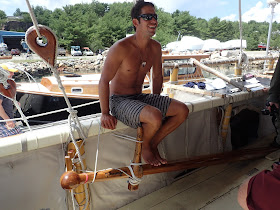 |
| Hokule'a off Oahu. (Photo: Polynesian Voyaging Society) |
We visited Hokule'a this weekend when she stopped in Bar Harbor, Maine. Because she was tied up to a pier with her rig stowed, we couldn't get a good view of what she really looks like, but we did go on board and took photos of some design and construction details. We also talked with Kaleo Wong, navigator on the most recent leg of the boat's voyage, about the mechanics of sailing a double crab-claw rig. (This is literally the first video we have ever done, so please be kind.)
 |
| The blade of the main steering sweep raised from the water. |
 |
| Lashings between one of the main cross-beams and one of the hulls. The boat is entirely lashed together. There are no mechanical fasteners. |
 |
| Hokule'a carries two idols on the vertical projections at the stern. On the port side (the female side of the boat) is a female figure. |
 |
| The main (center) steering sweep, looking aft. |
 |
| Another look at the main steering sweep, showing the lashings that hold it in place and serve as its pivot. |
NOTE: We're obliged to Sym (5) and Ars Sonor for free use of the nice ambient music we used for the intro and outro of the video.



I was glad to board the boat at Mystic, which I had waited to do ever since reading about it in the 1976 National Geographic. I understand its importance in the Hawaiian and general Polynesian Revival movements, but have been disappointed in one thing in the first function as a "performance replica" -- you can't quite call it that until you use the pandanus-leaf woven mat sails for an entire voyage. The performance of Dacron sails vs. the mat sails must be quite different. They used them very briefly, I believe, before abandoning them for Dacron. It was not because of availability -- Hawaiian women wove more than enough -- so much that some was donated to a museum(s). So that question will remain for the time being.
ReplyDeleteWade - good point about the sail material. One would assume that matting would behave quite differently from Dacron.
Delete